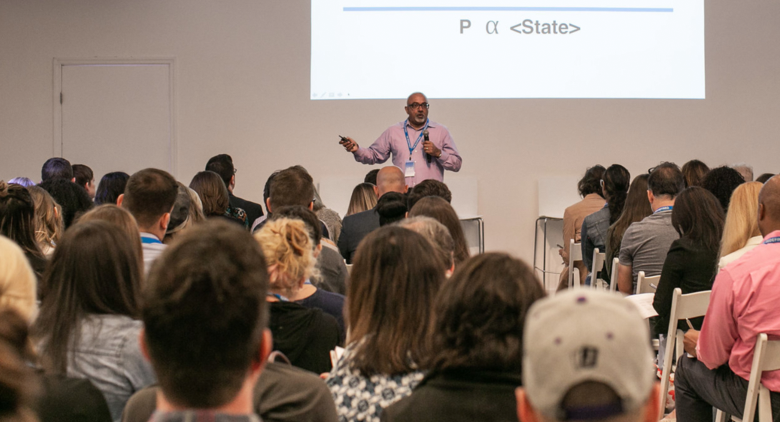
HR Experts Share Their Performance Management Tips

The field of human resources is changing. In our HR Redefined series, we give innovators a medium to share personal reflections, professional advice, and best practice guidance.
The following is a recap of a panel discussion at Namely’s 2017 Client Summit, moderated by Annie Rosencrans, Senior People Operations at Namely and featuring Colleen Clark, Head of Optimistic People at Life is Good; Sophia Mills, HR Coordinator at Apcera; and Heather Howe, Associate Director of Human Resources at Visual IQ.
Annie Rosencrans (Namely): How does culture influence the way you approach performance management?
Colleen Clark (Life is Good): We start with the idea that every employee has ‘superpowers’— simple things like creativity, authenticity, fun, humor, etc. This idea has been with us since the founding of the company and is embedded in our culture from the interview process to the review cycle.
I also approach performance management with the idea that conversation is the culture. The culture reflects what the founders and leaders talk about every day. If that conversation is about profit, but the leadership wants the culture to reflect the values, you’ll have a disconnect.
Sophia Mills (Apcera): We also have core values at Apcera, such as integrity and teamwork. But we struggle with continuous feedback because managers don’t always have time to do weekly 1:1s. I’m currently looking for a tool or a way to provide trainings that empower managers to give that feedback every day and and check in with employees more regularly.
Heather Howe (Visual IQ): Communication is key. Without communication employees can’t grow, and managers can’t understand employees as individuals and professionals. The last thing you want is to get to your annual review and find out all of these things you could have been doing for the past year.
We moved to quarterly conversations, so that there are no surprises. We’re making communication, transparency, and culture a priority to enhance Visual IQ as a whole and make sure employees understand where they are on a monthly, quarterly, and every day basis.
AR: It seems that you’re all moving toward a more continuous feedback model. How have you implemented that process?
CC: We do what we call “feedback on the fly.” This came from the idea that you would want somebody to tell you if you have spinach in your teeth. If you eat lunch at noon and nobody says anything, at 5pm you look in the mirror and realize it’s been there since lunch. So we use that as an example of coworkers helping each other throughout the day.
The same principle stands for more formalized performance reviews. The form is the canvas, but the conversation is the art. The art is always more valuable than the canvas and that’s the approach we have our managers take.
SM: We’re now trying to establish that mentality from day one. During onboarding, I tell new hires, “If you have a question, ask!” It’s a little trickier with existing employees who haven’t always given or received ongoing feedback. We organize bi-weekly happy hours, which we ask different employees to host, as well as trivia nights with teams made up of employees from across different departments. You have to get people to engage with each other to create a culture of feedback and support.
HH: Continuous feedback came out of necessity for us. I partnered with one of our Senior Directors who had done continuous feedback at his previous company, so he helped me get everything set up. We’re a little behind on quarterly-reviews, but my advice is to not worry about the when, but worry about the how first. You want to make sure you have a process in place that is as structured as possible.
AR: Along those lines, how do you take that continuous feedback and then implement it into the structured annual or quarterly review?
CC: Our employees complete a self-review and then the manager has 3 months to evaluate the quality of the review and make comments. We did this to take the burden off of the manager because we don’t want them to do reviews when they’re stressed or busy. We also changed our questions to make the conversation focus more on the individual, so managers can call out and appreciate individual strengths.
SM: Reviews should be focused on the future of an employee’s performance, rather than a time to wade through all of the things the person has already done. I think continuous feedback is the path to that type of performance management. That way, when you do have your annual review, you can focus the conversation on questions around what’s next, what are your professional goals, what are you good at, and how can we help you be better at what you do?
AR: What is the makeup of your reviews?
HH: Managers review employees against pre-established competencies that they specifically outlined. Employees receive guidelines so they know what they’re working toward, and we also have managers create an employee development plan.
SM: On our first review cycle, we ran into issues with 360 reviews. We let employees choose who would evaluate them, and they chose peers that they knew would give them high ratings. Even managers would give employees constructive feedback, but rate them in the highest bucket because they didn’t want to be too harsh. This gave us skewed results, so we’re rethinking our approach for the next cycle.
CC: We actually did away with competencies and ratings. Our employees set goals in Namely, and they are measured against these goals in their performance reviews. Managers focus on an employee’s cultural leadership and their contribution of ideas to the company.
AR: How do you manage peer reviews?
HH: I don’t like peer reviews. As Sophia mentioned, they’re like a reference. We restructured our peer reviews so that each employee has five total, two that they can choose, and three chosen by their manager. It’s hard because people are scared to be honest, but we’re trying to show them that it’s okay to have things that need to be improved upon.
I tell my managers that peer reviews are not the be-all and end-all of an employee, it’s just another nugget in your basket to help you understand your employee holistically. Managers see the employee one way, peers another, and the CEO even another way. Peer reviews are just something you want to pull out to be able to see that individual as a whole.
CC: We ripped the bandaid off and did a full peer review within the leadership team. We framed the first half of the questions in a positive way and the second half in a constructive way. When we finished, we had a meeting where we discussed all the answers. Some really productive and important conversations came out of this meeting, so we took it out and asked a team of volunteers to do the same thing. Next time we’ll take it out to the whole company.
SM: I think that’s fantastic. If your culture isn’t present in your leadership, it won’t be present in your company. If you can have that kind of transparency among your leaders, it will filter down to employees. We found that our employees wanted to give feedback, but didn’t want to give it to their peers directly. I love the idea that of showing employees what’s expected by having these transparent 360 leadership conversations. That way it won’t feel so scary when employees are asked to do it, and they’ll start talking to each other instead of around each other.
AR: How are you planning to take performance reviews to the next level for your next cycle?
HH: We’re still just starting the process. Our last cycle was the first time we had performance reviews in a software instead of in Excel. We’re focusing on educating the managers on the importance of giving feedback on a more continual basis.
SM: I’m working on moving performance management away from being a totally HR-driven process. I want to push it back to the managers to create it. They know their teams and their expectations better than I do. Competencies like “integrity,” while a great quality to have, are too broad and should be specific to the individual teams rather than to the broader company.
CC: We put out a culture survey twice a year with basic questions from Gallup mixed with our own questions. Then we have what we call “jig jams” to share the results and craft questions for next review cycle from the issues they raised. This gives employees the opportunity to continually share their voice on things that matter to them.
Looking to further your own performance review process? Check out our eBook, Your Performance Review Checkup.

See how Namely's flexible solution will help you streamline your HR processes by having your people, payroll, and benefits info all in on place.
Get a demoYou May Also Like
Get the latest news from Namely about HR, Payroll, and Benefits.
Thanks for subscribing!


Get the latest news from Namely about HR, Payroll, and Benefits.
Thanks for subscribing!



